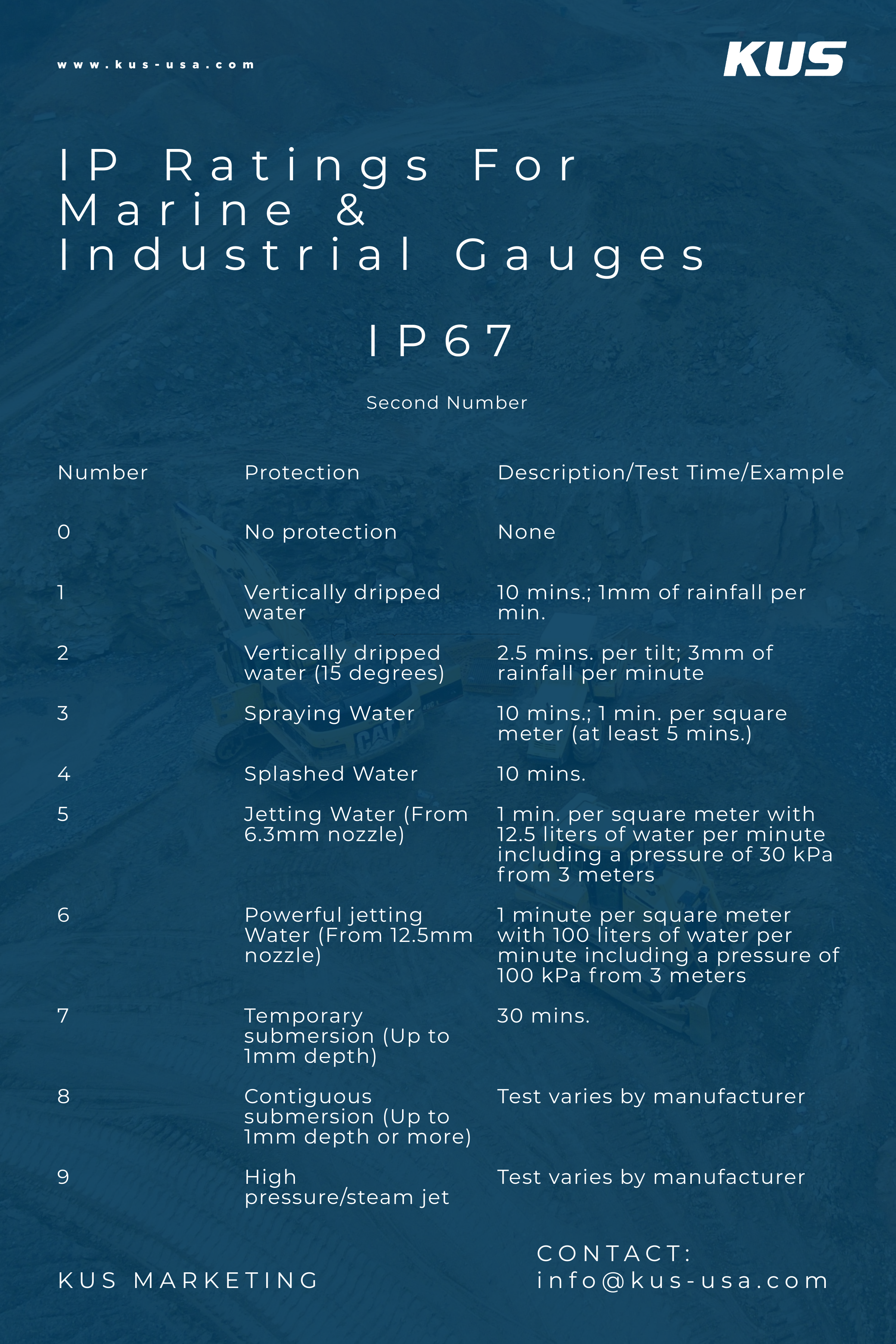When you’re in the market for gauges for any application, you will need to compare technical specifications. One key piece of information for instrumentation — whether for marine, industrial, construction, vehicle, or machinery — is the IP rating or IP code. By understanding IP ratings, you can make the best decisions when specifying gauges. If you sell to the public, this information can also help you to explain to your customers what they’re getting when they purchase gauges.
Definition of IP Ratings
IP stands for “international protection” officially or, more commonly, “ingress protection.” You may see either term: “IP code” or “IP rating.” Occasionally, you may also see “waterproof rating,” though this is not technically correct.
In the US, these ratings are codified by the International Electrotechnical Commission as IEC 60529. The international standards are laid out by the German Institute for Standardization in DIN 40050-9. The first edition of IEC 60529 was published in 1976, with subsequent updates. Products are put through validation testing to ensure they meet their stated codes.
Often, though not always, the rating is written as “IP” plus two digits, for example: IP50. The code describes how the housing of electrical equipment is protected against the ingress of dust and water. Secondarily, it indicates how much a person is protected against contact with any moving parts in the gauge. Keep in mind, it does not indicate if the instrument is suitable for special operating conditions. A manufacturer is responsible for communicating the rating to the customer, either on the packaging or on the instrument itself.
How to Interpret an IP Rating
Some people misinterpret an IP rating by reading the two digits as one number, in other words as “50” instead of as a five and a zero. It’s important to know what each digit represents.
First Two Digits
The first digit ranges from 0-6. It indicates how protected the component is against intrusion of solid particles, from no protection to dust-tight.

The second digit ranges from 0-9. It indicates how protected the component is against intrusion from moisture, from no protection to safe against high pressure water.

In some cases, an “x” may be present in place of either the first or second digits. This denotes that there is no ingress protection rating, so an “x” is essentially the same as a zero.
Additional Digits or Characters
A third, optional digit may also appear. Once included as part of the IP code, this third digit can now be seen as a standalone figure. It indicates protection against mechanical impact, from no impact to 20 joules of impact energy.
An additional letter may also appear. The letter indicates protection against different conditions and mediums, from oil resistance to weather conditions. A chart explaining what each level of IP rating means can be found here.
Where You Need Gauges with Strong Protection
Clearly, the strongest levels of ingress protection are needed where there is the greatest risk of damage from moisture or dust. Some examples of applications where you would want strong protection include:
- Boats, to protect against water and moisture intrusion as well as different types of corrosives
- Off-road vehicles, to protect against water and dust intrusion in different operational climates
- Construction vehicles and equipment, to protect against and possibly mechanical impact from heavy or falling objects
There are a number of risks of not having the correct rating for the application solution. Some of the most common include:
- Electrical failure
- Rust and/or corrosion
- Gradual decline in function
- Inability to adequately clean the gauge without risking damage
- Downtime resulting from unexpected repair(s)
In order to guard against any of these dangerous mishaps, it is important to select instruments with adequate protections. If you are unsure which IP rating you gauge would need, be sure to contact your supplier.
IP Ratings on KUS Products
KUS prides itself on the integrity of our products and the thorough in-house testing and validation we conduct on them. All of our gauge bodies and panels are highly protected, with a rating of IP67.
As a reminder, the first digit of 6 means the gauge is protected against dust and other particles, including a vacuum seal. The second digit of 7 means the gauge is protected against temporary immersion. The gauges are not built to withstand complete, continuous immersion or high-pressure cleaning. Rather, they are built for immersion up to 30 minutes to depths between 15 cm and 1m.
Customization is an option if different levels of protection are needed. Contact us to learn more about customizing and testing any instrumentation you need for your upcoming projects.
